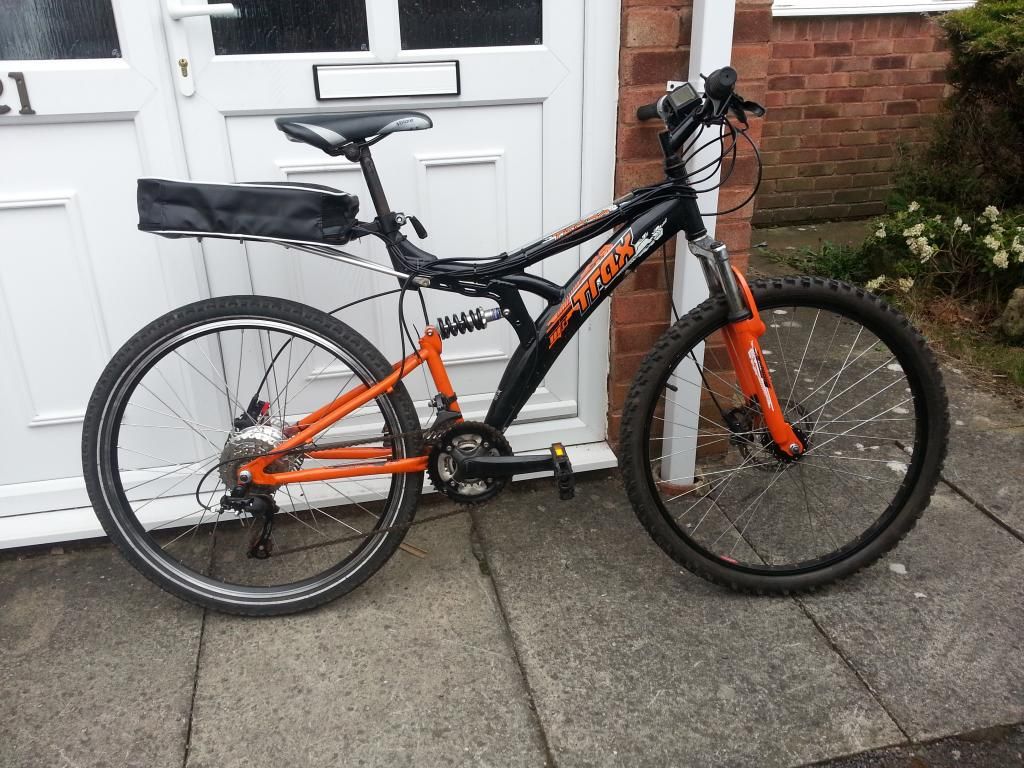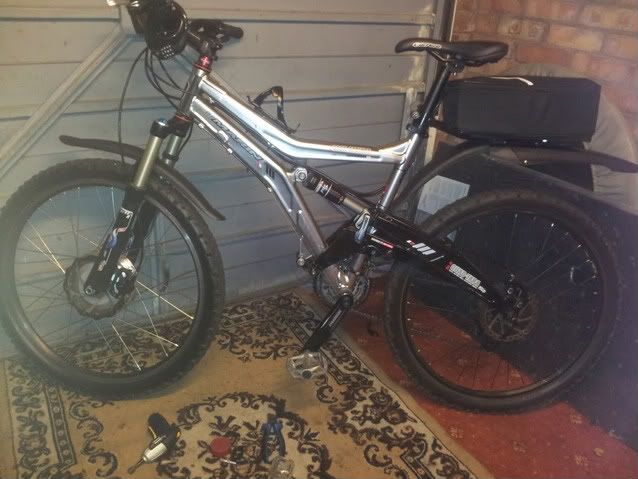I hate to have to say it, but you haven't chosen a very suitable bike as conversion candidate. It's possible to convert any bike if you have the wherewithal and knowhow, but until you have some experience, it's better to keep it simple.
When you want to do a conversion, it's much better to choose a motor system that you want to use, then go and find a suitable bike to put it on, rather than the other way round.
An electric bike is different to a normal bike. Many of the things that are good on a normal bike become less important when the bike is electrified, and often, they work against you when doing a conversion. That's not to say that a good quality bike doesn't make a good convresion. You have to find the right one.
These are the guide-lines that I use when choosing a donor bike:
1. A frame with a suitable location for a battery. Bikes with a triangle frame are good. You can use a rack-mounted battery on non suspension frames as long as the battery is not too big/heavy. Downtube mounted batteries are good.
2. Disc brakes. Normal rim brakes are are adequate for the low speed and light weight of a bicycle, but, IMHO, have no place on a heavier faster electric bike (generally, but with exceptions).
3. Space on the crank for a pedal sensor. Look between the chainwheel and the bottom bracket. Is there a 5mm gap to install the PAS? If not, is there a gap on the left side? A pedal sensor is necessary for a hub conversion, but not a crank-drive.
4. A space to put the throttle. The shape of the changers and brake levers often doesn't allow the larger diameter of a throttle to be fitted anywhere convenient.
5. Strong rear drop-outs if you want to fit a rear motor and somewhere convenient to anchor the torque arm. A side-mount disc mounting plate is good or flat drop-out that can be drilled through.
6. Steel forks if you want to use a front motor. Many of us and many OEMs have fitted motors in alloy forks. There's not too much risk if done properly. Steel forks are relatively risk free. They're more or less mandatory if you want to go higher than say 350w.
7. A non-suspension rear end. That's something to think about rather than essential. Full suspension complicates a rear motor installation and limits what sort of battery you can put on a rack. Obviously, it's no problem if you have a triangle frame for the battery and a crank-motor.
8. A 1 1/8" steering head. This is the standard for a reasonable quality front end. It gives the option to upgrade your forks to good quality ones that can improve your ride a lot. If you have any triangle frame with a 1/1/8" steering head, you can make a bike with very high quality components. Everything on a bike is easy to change - gears, brakes, forks, seat, crank. You can get used components on E-bay pretty cheaply, which means you can make a very high spec bike without spending much, or you can use cheaper stuff. You have the choice. A 1" steering head will limit what forks you can use to mainly crappy ones.
Having said all that, if you want to procede with your Marin, a crank-motor will probably be easiest, then a rear hub-motor. Have a word with Woosh Bikes about their crank-motor kits or look around for a Bafang BBS01. If you want anything else, drool all over the choice of mix-and-match stuff you can get from BMSBattery.com. They're really good if you want a bit more speed or power than the UK kits, whilst at the same time staying legal.
Coming back to a point I made before, when you have an electric bike, the motor can do all the work for you, which means that you don't necessarily need a high-spec bike. A nice motor and its control system are more important. Add a comfortable seat and you can forget the rest. Here's a bike that I rescued from a skip. I gave the guy £5 for it. It was exactly what I was looking for for a particular conversion. The motor I wanted to use was wider than normal so I needed a steel frame, which can be more easily stretched than aluminium. It had disc brakes as well, which is mandatory for my bikes. I didn't care about the rest because it was only meant to be a test bed; however, I did 1000 miles on it through the winter. During that time, riding it in all weathers including snow, it didn't require any maintenance or parts. I would have kept it if it weren't a little too small for me.

Here's a marin I converted, similar to yours. It was pretty good to ride and very powerful, though I wouldn't use a front motor if I did another because I've had and seen problems on other bikes. It doesn't show in the photo, but the front drop-outs were substantially reinforced with custom steel parts. Seat-tube racks can be used, but you should get the longest seat-pin possible, which will reinforce the frame and reduce the stress in it.












